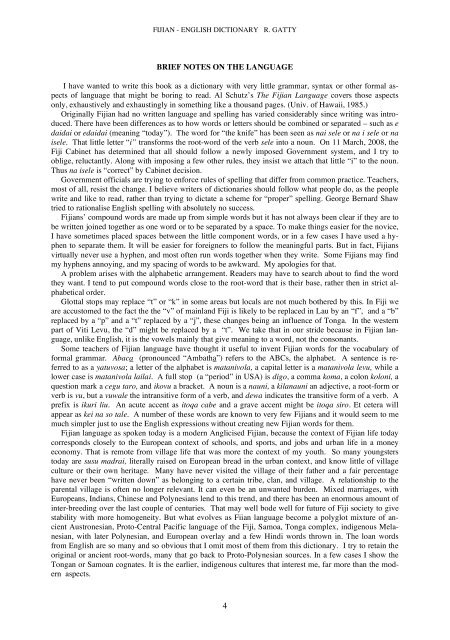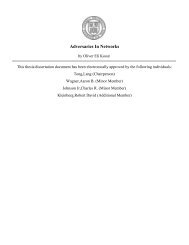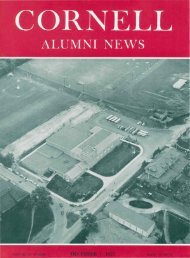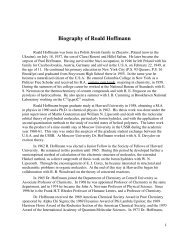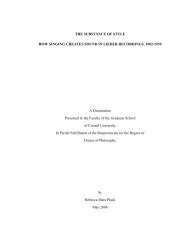Fijian-English Dictionary - eCommons@Cornell - Cornell University
Fijian-English Dictionary - eCommons@Cornell - Cornell University
Fijian-English Dictionary - eCommons@Cornell - Cornell University
You also want an ePaper? Increase the reach of your titles
YUMPU automatically turns print PDFs into web optimized ePapers that Google loves.
FIJIAN - ENGLISH DICTIONARY R. GATTY<br />
BRIEF NOTES ON THE LANGUAGE<br />
I have wanted to write this book as a dictionary with very little grammar, syntax or other formal aspects<br />
of language that might be boring to read. Al Schutz’s The <strong>Fijian</strong> Language covers those aspects<br />
only, exhaustively and exhaustingly in something like a thousand pages. (Univ. of Hawaii, 1985.)<br />
Originally <strong>Fijian</strong> had no written language and spelling has varied considerably since writing was introduced.<br />
There have been differences as to how words or letters should be combined or separated – such as e<br />
daidai or edaidai (meaning “today”). The word for “the knife” has been seen as nai sele or na i sele or na<br />
isele. That little letter “i” transforms the root-word of the verb sele into a noun. On 11 March, 2008, the<br />
Fiji Cabinet has determined that all should follow a newly imposed Government system, and I try to<br />
oblige, reluctantly. Along with imposing a few other rules, they insist we attach that little “i” to the noun.<br />
Thus na isele is “correct” by Cabinet decision.<br />
Government officials are trying to enforce rules of spelling that differ from common practice. Teachers,<br />
most of all, resist the change. I believe writers of dictionaries should follow what people do, as the people<br />
write and like to read, rather than trying to dictate a scheme for “proper” spelling. George Bernard Shaw<br />
tried to rationalise <strong>English</strong> spelling with absolutely no success.<br />
<strong>Fijian</strong>s’ compound words are made up from simple words but it has not always been clear if they are to<br />
be written joined together as one word or to be separated by a space. To make things easier for the novice,<br />
I have sometimes placed spaces between the little component words, or in a few cases I have used a hyphen<br />
to separate them. It will be easier for foreigners to follow the meaningful parts. But in fact, <strong>Fijian</strong>s<br />
virtually never use a hyphen, and most often run words together when they write. Some <strong>Fijian</strong>s may find<br />
my hyphens annoying, and my spacing of words to be awkward. My apologies for that.<br />
A problem arises with the alphabetic arrangement. Readers may have to search about to find the word<br />
they want. I tend to put compound words close to the root-word that is their base, rather then in strict alphabetical<br />
order.<br />
Glottal stops may replace “t” or “k” in some areas but locals are not much bothered by this. In Fiji we<br />
are accustomed to the fact the the “v” of mainland Fiji is likely to be replaced in Lau by an “f”, and a “b”<br />
replaced by a “p” and a “t” replaced by a “j”, these changes being an influence of Tonga. In the western<br />
part of Viti Levu, the “d” might be replaced by a “t”. We take that in our stride because in <strong>Fijian</strong> language,<br />
unlike <strong>English</strong>, it is the vowels mainly that give meaning to a word, not the consonants.<br />
Some teachers of <strong>Fijian</strong> language have thought it useful to invent <strong>Fijian</strong> words for the vocabulary of<br />
formal grammar. Abaca (pronounced “Ambatha”) refers to the ABCs, the alphabet. A sentence is referred<br />
to as a yatuvosa; a letter of the alphabet is matanivola, a capital letter is a matanivola levu, while a<br />
lower case is matanivola lailai. A full stop (a “period” in USA) is digo, a comma koma, a colon koloni, a<br />
question mark a cegu taro, and ikovu a bracket. A noun is a nauni, a kilanauni an adjective, a root-form or<br />
verb is vu, but a vuwale the intransitive form of a verb, and dewa indicates the transitive form of a verb. A<br />
prefix is ikuri liu. An acute accent as itoqa cabe and a grave accent might be itoqa siro. Et cetera will<br />
appear as kei na so tale. A number of these words are known to very few <strong>Fijian</strong>s and it would seem to me<br />
much simpler just to use the <strong>English</strong> expressions without creating new <strong>Fijian</strong> words for them.<br />
<strong>Fijian</strong> language as spoken today is a modern Anglicised <strong>Fijian</strong>, because the context of <strong>Fijian</strong> life today<br />
corresponds closely to the European context of schools, and sports, and jobs and urban life in a money<br />
economy. That is remote from village life that was more the context of my youth. So many youngsters<br />
today are susu madrai, literally raised on European bread in the urban context, and know little of village<br />
culture or their own heritage. Many have never visited the village of their father and a fair percentage<br />
have never been “written down” as belonging to a certain tribe, clan, and village. A relationship to the<br />
parental village is often no longer relevant. It can even be an unwanted burden. Mixed marriages, with<br />
Europeans, Indians, Chinese and Polynesians lend to this trend, and there has been an enormous amount of<br />
inter-breeding over the last couple of centuries. That may well bode well for future of Fiji society to give<br />
stability with more homogeneity. But what evolves as Fiian language become a polyglot mixture of ancient<br />
Austronesian, Proto-Central Pacific language of the Fiji, Samoa, Tonga complex, indigenous Melanesian,<br />
with later Polynesian, and European overlay and a few Hindi words thrown in. The loan words<br />
from <strong>English</strong> are so many and so obvious that I omit most of them from this dictionary. I try to retain the<br />
original or ancient root-words, many that go back to Proto-Polynesian sources. In a few cases I show the<br />
Tongan or Samoan cognates. It is the earlier, indigenous cultures that interest me, far more than the modern<br />
aspects.<br />
4


